8.06.2018
![]()
Slung under the belly of a specially-equipped carrier airplane, a Northrop Grumman Pegasus rocket took off Wednesday from Vandenberg Air Force Base on a two-day trek to a remote U.S. military test site in the Pacific Ocean, where crews will ready the air-dropped booster for launch of a NASA research satellite next week.
The ferry flight from California to Kwajalein Atoll in the mid-Pacific Ocean will position the Pegasus rocket, its carrier jet, and support teams for final preparations for launch June 14 with NASA’s Ionospheric Connection Explorer, or ICON, a satellite designed to probe the link between Earth’s atmosphere and space weather.
ICON is about the size of a refrigerator and weighs a little more than 600 pounds for launch. The $252 million project is NASA’s first mission dedicated to studying the influence of Earth’s weather on the ionosphere, an ever-changing layer in the upper atmosphere that affects long-distance communications and navigation.
It will ride into orbit at the forward end of a 55-foot-long (17-meter), three-stage Pegasus XL rocket, the world’s only operational air-launched orbital-class satellite booster.
The ICON spacecraft and the Pegasus XL rocket were built by Orbital ATK.
In a coincidental confluence of events, the company’s acquisition by Northrop Grumman closed Wednesday. Northrop Grumman announced the conclusion of the transaction soon after the Pegasus rocket’s L-1011 carrier aircraft, named “Stargazer,” left California on the two-leg journey to Kwajalein.
Orbital ATK, formed three years ago by the merger of Orbital Sciences and ATK, now functions as a distinct business unit within Northrop Grumman, and has been renamed Northrop Grumman Innovation Systems.
The three-engine L-1011 carrier jet took off from Vandenberg’s concrete runway with the Pegasus XL rocket at around 12 p.m. PDT (3 p.m. EDT; 1900 GMT) Wednesday, heading for an overnight layover at Hickam Air Force Base, Hawaii.
A charter jet carrying a team of launch controllers, engineers and technicians departed Vandenberg a couple of hours before the L-1011 carrier jet, also heading for an overnight refueling stop in Hawaii.
Both aircraft are scheduled to arrive at Bucholz Army Airfield at Kwajalein Atoll, located in the Marshall Islands, late Thursday, U.S. time.
![]()
The L-1011 carrier jet will fly through the Pegasus rocket’s planned drop box north of Kwajalein Atoll as it approaches the remote island, situated just west of the International Date Line. The launch team will run through the final steps of the Pegasus countdown checklist, and the U.S. Army’s Reagan Test Site at Kwajalein will activate range tracking equipment to simulate launch day procedures.
The rehearsal opportunity will give the Pegasus crew a chance to practice the countdown, and ensure range systems and a mobile control center recently set up at Kwajalein by an advance team are ready for launch day.
“We’ll do a practice dress rehearsal with all the actual radars and equipment that Reagan Test Site will be using for the mission to test that equipment with our rocket at the actual drop point, and with our crew in our control center that we’ve set up there, so that we can get an end-to-end check,” said Eric Denbrook, Northrop Grumman’s site manager and head of launch vehicle processing at Vandenberg Air Force Base, in an interview Monday. “That will be really close to what we’ll see on launch day.”
Once at Kwajalein, support crews will configure the already-assembled Pegasus XL rocket for launch, and engineers will ensure the solid-fueled booster and the ICON spacecraft weathered the nearly 5,000-mile (8,000-kilometer) journey from California unscathed.
Another compatibility check between the ICON spacecraft, Pegasus rocket, the Stargazer carrier plane, and the Reagan Test site is also planned this weekend. A final launch dress rehearsal is on tap early next week, including a test of data and telemetry relays between Kwajalein and the ICON satellite control center in Berkeley, California.
After final closeouts and launch preps, the L-1011 aircraft will take off from Kwajalein and head north to the Pegasus drop box. The L-1011’s co-pilot will command release of the 51,000-pound (23-metric ton) Pegasus XL at 39,000 feet (11,900 meters) during a planned 37-minute window opening June 14 at 1401 GMT (10:01 a.m. EDT).
The drop is currently targeted for around 1406 GMT (10:06 a.m. EDT), or 2:06 a.m. Kwajalein time on June 15, to begin an eight-minute climb into orbit roughly 357 miles (575 kilometers) above Earth.
Next week’s mission will mark the 44th launch of a Pegasus rocket on a satellite delivery mission, and the 34th in the Pegasus XL configuration with uprated solid rocket motors. It will be the fifth Pegasus mission staged from Kwajalein, a site which NASA and Northrop Grumman officials — then part of Orbital ATK — selected based on ICON’s target orbit and the rocket’s lift capability, which gets an extra boost from the island’s equatorial location.
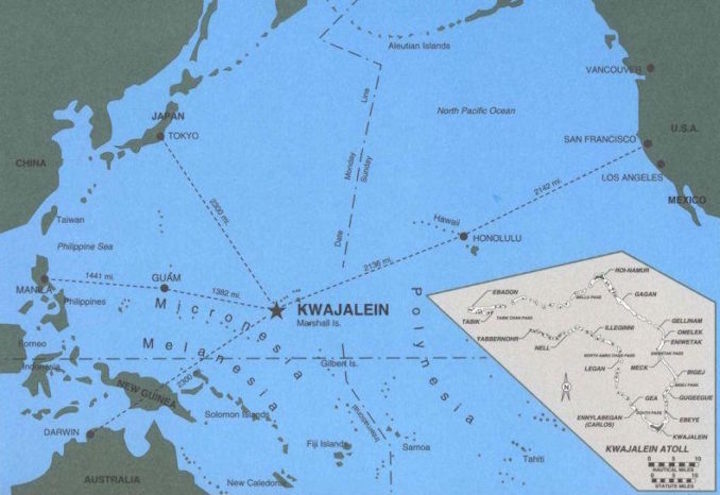
Now part of the U.S. military’s Reagan Test Site, Kwajalein Atoll is part of the Marshall Islands. Before the nation gained independence, the territory was administered by the United States, which took control of Kwajalein, known as Kwaj for short, in a World War 2 battle that left numerous shipwrecks and crashed airplanes in the atoll’s lagoon. Japan, Germany and Spain previously claimed Kwajalein and surrounding islands.
“There’s a lot of interesting history on Kwaj, so people who haven’t been there are kind of interested to go and see it for the first time,” Denbrook said. “For us, the struggle is making sure we have enough spares and parts.”
Kwajalein is around 2,400 miles (3,900 kilometers) southwest of Honolulu. Equipment needed by the L-1011 carrier jet, Pegasus ground control consoles, and other hardware required during the final days of the ICON launch campaign had to be transported by boat or airplane ahead of time.
“It’s hard to get things in and out of that island, so we have to make sure we’re prepared for any contingency that could take place,” Denbrook said. “From a logistics standpoint, that’s the toughest thing.”
Denbrook’s team prepared the Pegasus XL rocket for launch at Vandenberg’s Building 1555.
Workers assembled the rocket’s three stages, which arrived from a Northrop Grumman facility in Utah already packed with solid propellant, connected the Pegasus XL’s delta-shaped wing and articulating fins, then mated the ICON spacecraft to the launcher last month, a few weeks after its shipment from a factory in Gilbert, Arizona.
The final launch processing work included encapsulation of the ICON satellite inside the Pegasus rocket’s nose shroud, and the lifting of the launcher onto a transport trailer.
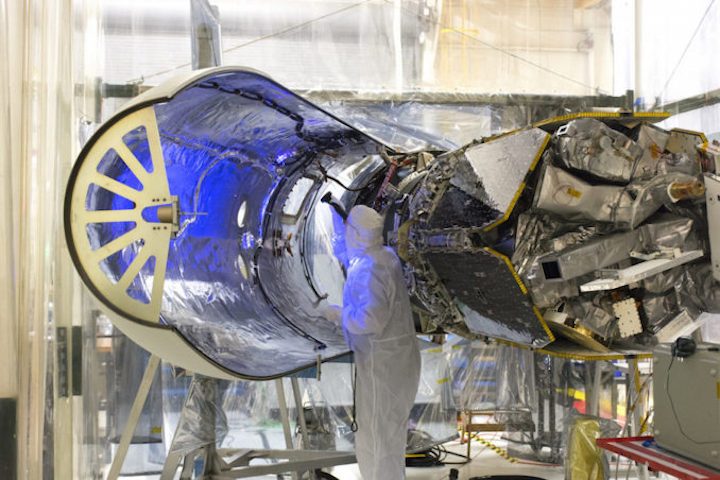
On Saturday morning, crews rolled the Pegasus XL out of Building 1555 to the Vandenberg airfield and under the belly of the L-1011 carrier plane, which was jacked off the ground to receive the rocket. Teams hooked the Pegasus to the aircraft Saturday afternoon, and ran a full checkout of electrical and telemetry connections between the vehicles and the Vandenberg range Sunday.
Engineers noticed some unexpected noise in the telemetry channels, prompting a one-day delay in the L-1011’s ferry flight from Tuesday to Wednesday.
ICON’s launch was delayed a year by a pair of concerns with its Pegasus launcher.
Engineers wanted more time to inspect the Pegasus rocket motors after they were mishandled during shipment to Vandenberg, officials said. That pushed the launch back from June to December 2017, the next availability in the military-run range at Kwajalein.
Then managers decided to ground the mission to assess the reliability of bolt-cutters used to jettison the Pegasus rocket’s payload fairing and separate the satellite in orbit. Bryan Baldwin, senior director of the Pegasus program at Orbital ATK, told Spaceflight Now that engineers opted to use slightly smaller quarter-inch diameter bolts for those functions on the ICON mission to ensure the bolt-cutter mechanisms do their job.
The quarter-inch bolts have flown on previous missions, and they still meet the Pegasus vehicle’s structural requirements, Baldwin said.
Officials have dedicated the rocket set to deliver ICON to space in honor of Ebb Harris, who piloted numerous Pegasus launch missions since the dawn of the program more than a quarter-century ago. Harris died earlier this year.
“Ebb has been a mentor to everyone who has come since the beginning of the program, a true gentleman, a very knowledgable and competent airman, and just a fun guy to be around,” said Don Walter, who will command the L-1011 aircraft during the ICON mission. “On every rocket that we launch, we have the ability to dedicate it to somebody, so if you look at the side of the rocket, you’ll see that this rocket is dedicated to Ebb.”
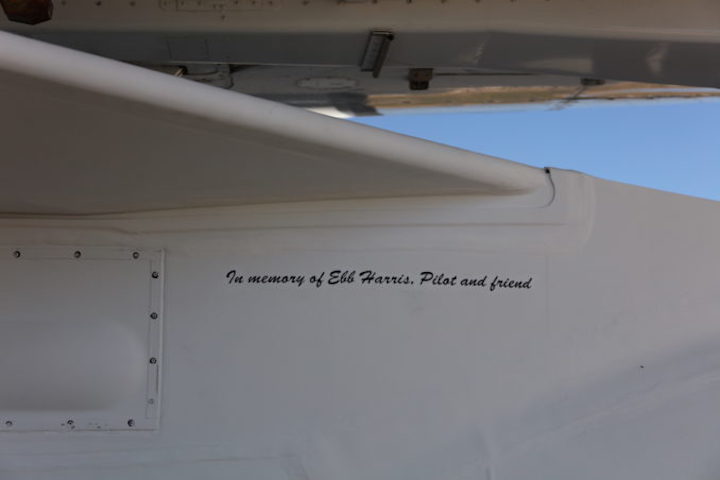
After its launch next week, ICON will go through a month of in-orbit testing before commencing science observations to examine a mysterious connection between the variability of the ionosphere with weather phenomena deeper in Earth’s atmosphere.
“The ionosphere is the densest plasma in space between us and the sun, and that plasma has a number of effects on systems that we use every day,” said Thomas Immel, ICON’s principal investigator at the University of California, Berkeley.
The ICON mission will study “how weather in our lower atmosphere, the weather we experience from day to day, influences conditions in space,” he said. “This coupling of the lower atmosphere to the upper atmosphere is a new science topic for NASA.”
Previous NASA missions detected a link between the weather in the lower atmosphere to changes in the ionosphere, which scientists had thought was primarily driven by solar activity.
“We saw with those missions that the density in the ionosphere varied in response to changes in the rainy seasons in the tropics,” Immel said. “The new mission of ICON is to focus on that topic, and we’re carrying the instruments to invesitgate that region.
“We think focusing on that will give us a real key to understanding and making better predictions for space weather,” he said.
Quelle: SN
---
Update: 9.06.2018
.
Carrier jet with Pegasus rocket returning to California, postponing NASA satellite launch
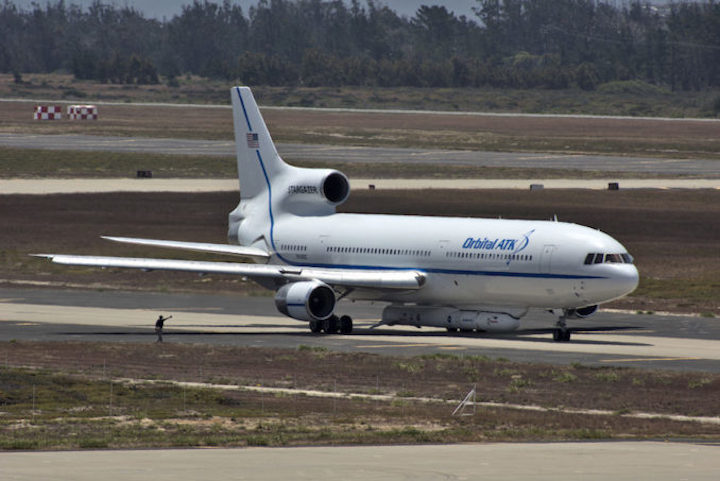
NASA and Northrop Grumman officials decided Friday to return a Pegasus rocket and its carrier aircraft from Hawaii to California, aborting a trip to Kwajalein Atoll in the Pacific Ocean for next week’s scheduled launch of a NASA research satellite to conduct additional testing.
The return trip to California will postpone the launch of NASA’s Ionospheric Connection Explorer, known as ICON, indefinitely. Launch was scheduled for next Thursday, June 14, U.S. time.
“Northrop Grumman, working with NASA, has made the decision to postpone the June 14 launch of the Pegasus XL rocket, carrying the ICON spacecraft,” the company said in a statement. “The company will return Pegasus to Vandenberg Air Force Base to conduct testing of the rocket after off-nominal data was seen during the ferry flight.
“Upon further review of the data, the teams will work to determine a new launch date,” the statement said. “As always, Northrop Grumman works with NASA to base its launch decisions on assuring mission success for our customer.”
The U.S. Army’s Reagan Test Site, which manages the launch range at Kwajalein, has limited windows available for civilian launchers like the Pegasus. The Pegasus rocket’s return to California is expected to cause the mission to miss its narrow launch opportunity in June, prompting a delay that could be measured in months.
The air-launched Pegasus XL rocket, nestled under the belly of an L-1011 carrier jet, departed Vandenberg Air Force Base, California, on Wednesday, heading for an overnight stop at Hickam Air Force Base, Hawaii, en route to Kwajalein Atoll, home to a U.S. military launch range in the mid-Pacific Ocean.
But teams reversed course after detecting a technical problem on the first leg of the journey. The nature of the “off-nominal data” found during the ferry flight was not announced as of Friday afternoon, and a NASA spokesperson did not provide further information when asked.
The L-1011 aircraft, along with a team of controllers, technicians and engineers making the trip on a charter airplane, did not take off for Kwajalein as planned Thursday, and officials decided Friday to bring the rocket back to Vandenberg Air Force Base, where Pegasus launchers are assembled and readied for missions.
The online flight tracking website FlightAware.com showed the charter plane with members of the ICON team took off from Honolulu on Friday bound for Vandenberg. A flight plan for the L-1011 aircraft, carrying the Pegasus rocket, showed it was scheduled to leave Hawaii later Friday.
The ICON satellite is fastened to the forward end of the 55-foot-long (17-meter) Pegasus rocket. ICON will probe the link between Earth’s atmosphere and space weather.
ICON is about the size of a refrigerator and weighs a little more than 600 pounds for launch. The $252 million project is NASA’s first mission dedicated to studying the influence of Earth’s weather on the ionosphere, an ever-changing layer in the upper atmosphere that affects long-distance communications and navigation.
The mission was set to be the first satellite launch conducted by Northrop Grumman after the aerospace contractor’s purchase of Orbital ATK, which developed the Pegasus rocket. Orbital ATK has conducted 43 satellite launches with Pegasus rockets since 1990, and a record which includes 29 successful orbital-class missions in a row since 1997.
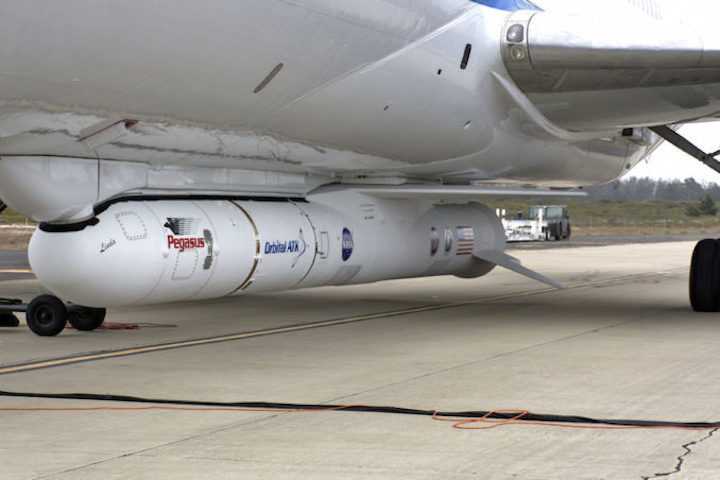
ICON will be the fifth Pegasus mission staged from Kwajalein, a site which NASA and Northrop Grumman officials — then part of Orbital ATK — selected based on ICON’s target orbit and the rocket’s lift capability, which gets an extra boost from the island’s equatorial location.
The Pegasus team had pre-staged key equipment, including launch control consoles and spares for the Pegasus rocket and the L-1011 carrier aircraft, at Kwajalein months before the mission’s scheduled takeoff.
Located in the Marshall Islands, Kwajalein is around 2,400 miles (3,900 kilometers) southwest of Honolulu, just west of the International Date Line.
ICON’s launch has been delayed a year by a pair of concerns with its Pegasus launcher.
Engineers wanted more time to inspect the Pegasus rocket motors after they were mishandled during shipment to Vandenberg, officials said. That pushed the launch back from June to December 2017, the next availability in the military-run range at Kwajalein.
Then managers decided to ground the mission to assess the reliability of bolt-cutters used to jettison the Pegasus rocket’s payload fairing and separate the satellite in orbit. Workers installed smaller bolts in the fairing and satellite separation
Quelle: SN
